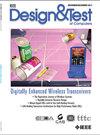The Bottom Line of Complex ICs and Systems on Chip [From the EIC]
引用次数: 0
Abstract
h THIS ISSUE OF IEEE Design & Test brings to our readers a selection of highly progressive and relevant topics, focusing intently on solutions to some of today’s most challenging areas facing the design, manufacturing, and deployment of complex ICs and systems on chip. The articles highlight advances in yield improvement, design methodologies, testing, diagnosis, and temperature and power management in 3-D ICs and mixed signal circuits. I am again very pleased to present another timely issue on the fringe of our industry’s progression. By reading the articles, as I mention below, they all very much address the bottom line! This usually matters to most if not all of us! Read on! Our first article will be of interest to a broad set of constituents, from designers, to process engineers, to quality assurance personnel, and more. It comes from an international group of authors ranging from Cadence Design Systems, to UCLA and the Missouri University of Science and Technology, to Nanyang Technological University in Singapore. It is a wellknown fact that process variations in deeply scaled technologies create major design and fabrication challenges. Accurately predicting yield for analog and mixed signal circuits is equally challenging but extremely important to the success of a product and company. The article here is focused precisely on yield estimation. The authors present two distinct approaches, one that is referred to as a performance domain method, and a second referred to as a parameter domain method. The authors present a thorough analysis of the tradeoffs of these two approaches through a number of circuit examples and quantitative comparisons of the efficiency of the two different methods. The second article, by a group of Taiwanese authors, moves us back to the emerging world of 3-D ICs and yield. The authors focused their work on the integrity of interconnects in 3-D ICs, which has major impact on yield of such chips. They address design for testability, built-in self-test, and defect diagnosis and repair in 3-D ICs that are based on through silicon vias (TSVs) and interposers. The claimed improvement results are significant and should make a difference to the bottom line! Following this, Bhagavatula et al. from Purdue University present a detailed view of the issues faced in the development and implementation of real-time power sensors that may be the key to successful and cost-effective intelligent power management in highperformance ICs and systems. The authors make the point that the need for accurate on-chip estimation of load currents is critical. They present a proposed solution approach to this challenge and discuss broader issues surrounding power management. Rounding out this general-interest issue, an article by Huang and Huang from the National Tsing Hua University in Taiwan takes us back to a test and yield/binning problem with 3-D TSV ICs. The authors present the usefulness of a cell-based phaselocked loop that can be synthesized ‘‘automatically’’ to generate an on-chip clock signal reaching 1 GHz. They show how such a clock can be useful to accurately bin 3-D ICs for TSV leakage. Again, one would expect such an approach to make a difference to the bottom line. To stretch our reader’s minds and interests, a tutorial article takes us to the world of mechanical engineering, and more specifically to the world of复杂集成电路和片上系统的底线[来自EIC]
这一期的IEEE设计与测试为我们的读者带来了一系列高度进步和相关的主题,专注于解决当今一些最具挑战性的领域,这些领域面临着复杂的集成电路和芯片系统的设计、制造和部署。文章重点介绍了3-D集成电路和混合信号电路在产量改进、设计方法、测试、诊断、温度和电源管理方面的进展。我再次非常高兴地在我们行业发展的边缘提出另一个及时的问题。通过阅读这些文章,正如我在下面提到的,它们都非常关注底线!这对我们大多数人来说都很重要。继续读下去!我们的第一篇文章将会引起很多人的兴趣,从设计人员到过程工程师,再到质量保证人员等等。它来自一个国际作者小组,包括Cadence Design Systems、加州大学洛杉矶分校(UCLA)、密苏里科技大学(Missouri University of Science and Technology)和新加坡南洋理工大学(Nanyang Technological University)。众所周知,深度规模化技术中的工艺变化会带来重大的设计和制造挑战。准确预测模拟和混合信号电路的良率同样具有挑战性,但对产品和公司的成功极为重要。本文的重点是产量估计。作者提出了两种不同的方法,一种称为性能域方法,另一种称为参数域方法。作者通过一些电路实例和两种不同方法效率的定量比较,对这两种方法的权衡进行了彻底的分析。第二篇文章由一群台湾作者撰写,将我们带回到新兴的3d集成电路和收益率世界。作者将他们的工作重点放在3-D集成电路互连的完整性上,这对这类芯片的成品率有重大影响。它们解决了基于硅通孔(tsv)和中间体的3-D集成电路的可测试性设计、内置自检以及缺陷诊断和修复。声称的改进结果是显著的,应该对底线产生影响!在此之后,来自普渡大学的Bhagavatula等人详细介绍了实时功率传感器的开发和实施所面临的问题,这些问题可能是高性能集成电路和系统中成功且具有成本效益的智能电源管理的关键。作者指出,对负载电流进行精确的片上估计是至关重要的。他们提出了一种针对这一挑战的拟议解决方案,并讨论了围绕电源管理的更广泛问题。台湾国立清华大学的Huang和Huang撰写的一篇文章将我们带回到3d TSV集成电路的测试和yield/binning问题,以解决这个普遍感兴趣的问题。作者提出了一种基于单元的锁相环的实用性,该锁相环可以“自动”合成以产生达到1ghz的片上时钟信号。他们展示了这样一个时钟如何能够用于精确地检测TSV泄漏的3-D集成电路。同样,人们会期望这样的方法对底线产生影响。为了拓展读者的思维和兴趣,一篇教程文章将我们带到了机械工程的世界,更具体地说,是
本文章由计算机程序翻译,如有差异,请以英文原文为准。
求助全文
约1分钟内获得全文
求助全文

 求助内容:
求助内容: 应助结果提醒方式:
应助结果提醒方式:


